22.3: The Biodiversity Crisis - HIPPPOC
- Page ID
- 118172
\( \newcommand{\vecs}[1]{\overset { \scriptstyle \rightharpoonup} {\mathbf{#1}} } \)
\( \newcommand{\vecd}[1]{\overset{-\!-\!\rightharpoonup}{\vphantom{a}\smash {#1}}} \)
\( \newcommand{\dsum}{\displaystyle\sum\limits} \)
\( \newcommand{\dint}{\displaystyle\int\limits} \)
\( \newcommand{\dlim}{\displaystyle\lim\limits} \)
\( \newcommand{\id}{\mathrm{id}}\) \( \newcommand{\Span}{\mathrm{span}}\)
( \newcommand{\kernel}{\mathrm{null}\,}\) \( \newcommand{\range}{\mathrm{range}\,}\)
\( \newcommand{\RealPart}{\mathrm{Re}}\) \( \newcommand{\ImaginaryPart}{\mathrm{Im}}\)
\( \newcommand{\Argument}{\mathrm{Arg}}\) \( \newcommand{\norm}[1]{\| #1 \|}\)
\( \newcommand{\inner}[2]{\langle #1, #2 \rangle}\)
\( \newcommand{\Span}{\mathrm{span}}\)
\( \newcommand{\id}{\mathrm{id}}\)
\( \newcommand{\Span}{\mathrm{span}}\)
\( \newcommand{\kernel}{\mathrm{null}\,}\)
\( \newcommand{\range}{\mathrm{range}\,}\)
\( \newcommand{\RealPart}{\mathrm{Re}}\)
\( \newcommand{\ImaginaryPart}{\mathrm{Im}}\)
\( \newcommand{\Argument}{\mathrm{Arg}}\)
\( \newcommand{\norm}[1]{\| #1 \|}\)
\( \newcommand{\inner}[2]{\langle #1, #2 \rangle}\)
\( \newcommand{\Span}{\mathrm{span}}\) \( \newcommand{\AA}{\unicode[.8,0]{x212B}}\)
\( \newcommand{\vectorA}[1]{\vec{#1}} % arrow\)
\( \newcommand{\vectorAt}[1]{\vec{\text{#1}}} % arrow\)
\( \newcommand{\vectorB}[1]{\overset { \scriptstyle \rightharpoonup} {\mathbf{#1}} } \)
\( \newcommand{\vectorC}[1]{\textbf{#1}} \)
\( \newcommand{\vectorD}[1]{\overrightarrow{#1}} \)
\( \newcommand{\vectorDt}[1]{\overrightarrow{\text{#1}}} \)
\( \newcommand{\vectE}[1]{\overset{-\!-\!\rightharpoonup}{\vphantom{a}\smash{\mathbf {#1}}}} \)
\( \newcommand{\vecs}[1]{\overset { \scriptstyle \rightharpoonup} {\mathbf{#1}} } \)
\( \newcommand{\vecd}[1]{\overset{-\!-\!\rightharpoonup}{\vphantom{a}\smash {#1}}} \)
\(\newcommand{\avec}{\mathbf a}\) \(\newcommand{\bvec}{\mathbf b}\) \(\newcommand{\cvec}{\mathbf c}\) \(\newcommand{\dvec}{\mathbf d}\) \(\newcommand{\dtil}{\widetilde{\mathbf d}}\) \(\newcommand{\evec}{\mathbf e}\) \(\newcommand{\fvec}{\mathbf f}\) \(\newcommand{\nvec}{\mathbf n}\) \(\newcommand{\pvec}{\mathbf p}\) \(\newcommand{\qvec}{\mathbf q}\) \(\newcommand{\svec}{\mathbf s}\) \(\newcommand{\tvec}{\mathbf t}\) \(\newcommand{\uvec}{\mathbf u}\) \(\newcommand{\vvec}{\mathbf v}\) \(\newcommand{\wvec}{\mathbf w}\) \(\newcommand{\xvec}{\mathbf x}\) \(\newcommand{\yvec}{\mathbf y}\) \(\newcommand{\zvec}{\mathbf z}\) \(\newcommand{\rvec}{\mathbf r}\) \(\newcommand{\mvec}{\mathbf m}\) \(\newcommand{\zerovec}{\mathbf 0}\) \(\newcommand{\onevec}{\mathbf 1}\) \(\newcommand{\real}{\mathbb R}\) \(\newcommand{\twovec}[2]{\left[\begin{array}{r}#1 \\ #2 \end{array}\right]}\) \(\newcommand{\ctwovec}[2]{\left[\begin{array}{c}#1 \\ #2 \end{array}\right]}\) \(\newcommand{\threevec}[3]{\left[\begin{array}{r}#1 \\ #2 \\ #3 \end{array}\right]}\) \(\newcommand{\cthreevec}[3]{\left[\begin{array}{c}#1 \\ #2 \\ #3 \end{array}\right]}\) \(\newcommand{\fourvec}[4]{\left[\begin{array}{r}#1 \\ #2 \\ #3 \\ #4 \end{array}\right]}\) \(\newcommand{\cfourvec}[4]{\left[\begin{array}{c}#1 \\ #2 \\ #3 \\ #4 \end{array}\right]}\) \(\newcommand{\fivevec}[5]{\left[\begin{array}{r}#1 \\ #2 \\ #3 \\ #4 \\ #5 \\ \end{array}\right]}\) \(\newcommand{\cfivevec}[5]{\left[\begin{array}{c}#1 \\ #2 \\ #3 \\ #4 \\ #5 \\ \end{array}\right]}\) \(\newcommand{\mattwo}[4]{\left[\begin{array}{rr}#1 \amp #2 \\ #3 \amp #4 \\ \end{array}\right]}\) \(\newcommand{\laspan}[1]{\text{Span}\{#1\}}\) \(\newcommand{\bcal}{\cal B}\) \(\newcommand{\ccal}{\cal C}\) \(\newcommand{\scal}{\cal S}\) \(\newcommand{\wcal}{\cal W}\) \(\newcommand{\ecal}{\cal E}\) \(\newcommand{\coords}[2]{\left\{#1\right\}_{#2}}\) \(\newcommand{\gray}[1]{\color{gray}{#1}}\) \(\newcommand{\lgray}[1]{\color{lightgray}{#1}}\) \(\newcommand{\rank}{\operatorname{rank}}\) \(\newcommand{\row}{\text{Row}}\) \(\newcommand{\col}{\text{Col}}\) \(\renewcommand{\row}{\text{Row}}\) \(\newcommand{\nul}{\text{Nul}}\) \(\newcommand{\var}{\text{Var}}\) \(\newcommand{\corr}{\text{corr}}\) \(\newcommand{\len}[1]{\left|#1\right|}\) \(\newcommand{\bbar}{\overline{\bvec}}\) \(\newcommand{\bhat}{\widehat{\bvec}}\) \(\newcommand{\bperp}{\bvec^\perp}\) \(\newcommand{\xhat}{\widehat{\xvec}}\) \(\newcommand{\vhat}{\widehat{\vvec}}\) \(\newcommand{\uhat}{\widehat{\uvec}}\) \(\newcommand{\what}{\widehat{\wvec}}\) \(\newcommand{\Sighat}{\widehat{\Sigma}}\) \(\newcommand{\lt}{<}\) \(\newcommand{\gt}{>}\) \(\newcommand{\amp}{&}\) \(\definecolor{fillinmathshade}{gray}{0.9}\)22.3 - The Biodiversity Crisis - HIPPPOC
- Please read and watch the following Learning Resources
- Reading the material for understanding, and taking notes during videos, will take approximately 1.5 hours.
- Optional Activities are embedded.
- To navigate to the next section, use the Contents menu at the top of the page OR the right arrow on the side of the page.
- If on a mobile device, use the Contents menu at the top of the page OR the links at the bottom of the page.
- Identify and explain the major causes of anthropogenic global change and their impacts on biodiversity.
Introduction
The core threat to biodiversity on the planet, and therefore a threat to human welfare, is the combination of human population growth and the resources used by that population. The human population requires resources to survive and grow, and many of those resources are being removed unsustainably from the environment. The three greatest proximate threats to biodiversity are habitat loss, overexploitation (also known as overharvesting), pollution, predator losses, and introduction of invasive species. These are a direct result of human population growth, resource use, increased mobility, and trade. One of the major causes of extinction, anthropogenic climate change, is covered in more depth later in the course.
Together, these threats are known as HIPPPOC: habitat loss, invasive species, pollution, population (human), predator loss, overexploitation, and climate change.
Habitat Loss
Humans rely on technology to modify their environment and make it habitable. Other species cannot do this. Elimination of their habitat—whether it is a forest, coral reef, grassland, or flowing river—will kill the individuals in the species. Remove the entire habitat and the species will become extinct, unless they are among the few species that do well in human-built environments. Human destruction of habitats accelerated in the latter half of the twentieth century.
Consider the exceptional biodiversity of Sumatra: it is home to one species of orangutan, a species of critically endangered elephant, and the Sumatran tiger, but half of Sumatra’s forest is now gone. The neighboring island of Borneo, home to the other species of orangutan, has lost a similar area of forest. Forest loss continues in protected areas of Borneo. The orangutan in Borneo is listed as endangered by the International Union for Conservation of Nature (IUCN), but it is simply the most visible of thousands of species that will not survive the disappearance of the forests of Borneo. The forests are removed for timber and to plant palm oil plantations (Figure \(\PageIndex{1}\)). Palm oil is used in many products including food products, cosmetics, and biodiesel in Europe. A 5-year estimate of global forest cover loss for the years from 2000 to 2005 was 3.1%. Much loss (2.4%) occurred in the tropics where forest loss is primarily from timber extraction. These losses certainly also represent the extinction of species unique to those areas.
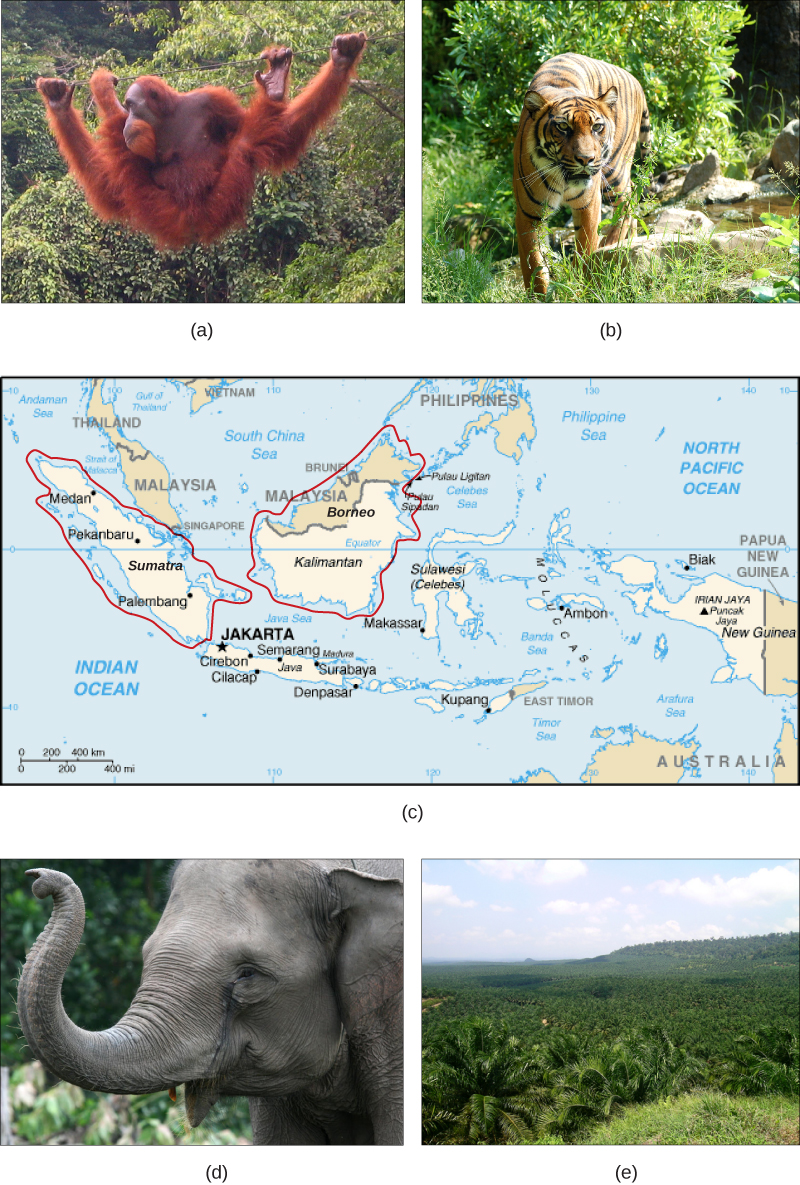
Most consumers do not imagine that the home improvement products they buy might be contributing to habitat loss and species extinctions. Yet the market for illegally harvested tropical timber is huge, and the wood products often find themselves in building supply stores. How is it possible to determine if a wood product, such as flooring, was harvested sustainably or even legally?
Various certifications can identify sustainably harvested forest products. Looking for certifications on flooring and other hardwood products is one way to ensure that the wood has not been taken illegally from a tropical forest. Some of these certifications are run by timber companies, however, thus creating a conflict of interest. Another approach is to buy domestic wood species. While it would be great if there was a list of legal versus illegal woods, it is not that simple. Logging and forest management laws vary from country to country; what is illegal in one country may be legal in another. Where and how a product is harvested and whether the forest from which it comes is being sustainably maintained all factor into whether a wood product will be certified. It is always a good idea to ask questions about where a wood product came from and how the supplier knows that it was harvested legally.
Habitat destruction can affect ecosystems other than forests. Rivers and streams are important ecosystems and are frequently the target of habitat modification. Damming of rivers affects flow and access to habitat. Altering a flow regime can reduce or eliminate populations that are adapted to seasonal changes in flow. Many fish species, including salmon, have seen declines caused by river damming and habitat loss.
Research has confirmed that species of amphibians that must carry out parts of their life cycles in both aquatic and terrestrial habitats are at greater risk of population declines and extinction because of the increased likelihood that one of their habitats or access between them will be lost. This is of particular concern because amphibians have been declining in numbers and going extinct more rapidly than many other groups for a variety of possible reasons.
Foresters identify strategies to manage forest habitats sustainably by mimicking natural processes in this 3.5-minute video from the World Wildlife Fund.
Question after watching: What are benefits to sustainable logging as described in the video?
Invasive Species
Non-native species are those that have been intentionally or unintentionally introduced by humans into an ecosystem in which they did not evolve. Human transportation of people and goods, including the intentional transport of organisms for trade, has dramatically increased the introduction of species into new ecosystems. These new introductions are often at distances that are well beyond the capacity of the species to ever travel on its own, and outside the range of the species’ natural predators.
Most non-native species introductions probably fail because of the low number of individuals introduced or poor adaptation to the ecosystem they enter. Some species, however, have characteristics that can make them especially successful in a new ecosystem. These non-native species may undergo dramatic population increases in their new habitat and reset the ecological conditions in the new environment, threatening the native species that already exist there. When this happens, the non-native species is termed an invasive species. Invasive species can threaten other species through competition for resources, increased predation, or by causing new diseases.
Many invasive species are well suited evolutionarily to exploiting human transportation as a means to migrate, whether by air, sea, or land. The accidental introduction of the brown tree snake via aircraft (Figure \(\PageIndex{2}\)) from the Solomon Islands to Guam in 1950 led to the extinction of three species of birds and three to five species of reptiles endemic to the island. Several other species are still threatened. Islands do not make up a large area of land on the globe, but they do contain a disproportionate number of endemic species because of their isolation from mainland ancestors.
Lakes and islands are particularly vulnerable to extinction threats from non-native species. In Lake Victoria, the intentional introduction of the Nile perch was largely responsible for the extinction of about 200 species of cichlids. Many introductions of aquatic species, both marine and freshwater, have occurred when ships have dumped ballast water taken on at a port of origin into waters at a destination port. Water from the port of origin is pumped into tanks on a ship empty of cargo to increase stability. The water is drawn from the ocean or estuary of the port and typically contains living organisms such as plant parts, microorganisms, eggs, larvae, or aquatic animals. The water is then pumped out before the ship takes on cargo at the destination port, which may be on a different continent.
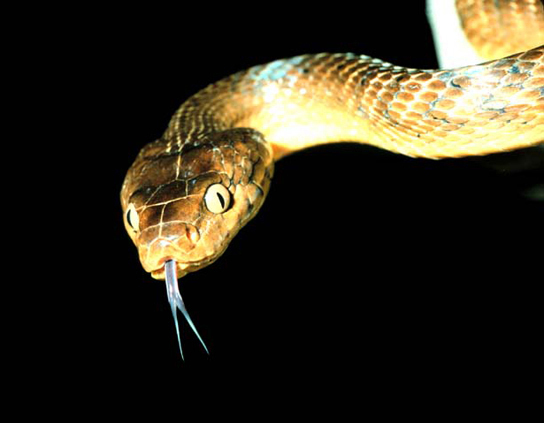
Invading exotic species can also be disease organisms. It now appears that the global decline in amphibian species recognized in the 1990s is, in some part, caused by the fungus Batrachochytrium dendrobatidis, which causes the disease chytridiomycosis (Figure \(\PageIndex{3}\)). There is evidence that the fungus is native to Africa and may have been spread throughout the world by transport of a commonly used laboratory and pet species: the African clawed frog, Xenopus laevis. It may well be that biologists themselves are responsible for spreading this disease worldwide. The North American bullfrog, Rana catesbeiana, which has also been widely introduced as a food animal but which easily escapes captivity, survives most infections of B. dendrobatidis and can act as a reservoir for the disease.
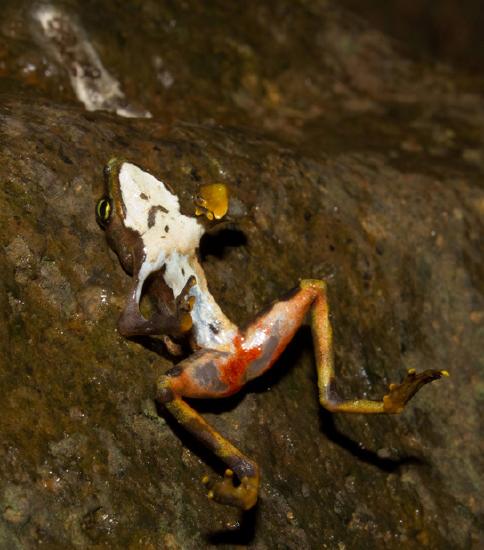
In this 5-minute video, discover the devastating impact that invasive species can have on ecosystems.
Question after watching: Do some research to find out what invasive species are a problem in your area? What is being done to combat them?
Invasive predator species are especially threatening to what kind of ecosystem?
- deserts
- marine ecosystems
- islands
- tropical forests
- Answer
-
C. islands
Pollution
Air Pollution
Air pollution occurs in many forms but can generally be thought of as gaseous and particulate contaminants that are present in the earth’s atmosphere. Chemicals discharged into the air that have a direct impact on the environment are called primary pollutants. These primary pollutants sometimes react with other chemicals in the air to produce secondary pollutants.
Outdoor air pollution involves exposures that take place outside of the built environment. Examples include fine particles produced by the burning of coal, noxious gases such as sulfur dioxide, nitrogen oxides and carbon monoxide; ground-level ozone and tobacco smoke. Indoor air pollution involves exposures to particulates, carbon oxides, and other pollutants carried by indoor air or dust. Examples include household products and chemicals, out-gassing of building materials, allergens (cockroach and mouse dropping, mold, pollen), and tobacco smoke.
A point source of air pollution refers to an emission source that does not move including factories, power plants, and dry cleaners. The term non-point sources is used to describe many sources of air pollution located together whose individual emissions may be below thresholds of concern, but whose collective emissions can be significant. Non-point sources include the construction of housing developments, runoff from asphalt, and landfills. In crop production, the misapplication of fertilizers, herbicides, and pesticides can potentially result in aerial drift of these materials and harm may be caused.
In this 4-minute video from National Geographic, learn how greenhouse gasses, smog, and toxic pollutants affect climate change and human health.
Question after watching: What strategies beyond those discussed in the video do you think will help to reduce air pollution?
Unlike the above-mentioned sources of air pollution, air pollution caused by natural sources is not caused by people or their activities. An erupting volcano emits particulate matter and gases, forest and prairie fires can emit large quantities of pollutants, dust storms can create large amounts of particulate matter, and plants and trees naturally emit volatile organic compounds which can form aerosols that can cause a natural blue haze.
Water Pollution
Water pollution is the contamination of water by an excess amount of a substance that can cause harm to human beings and/or the ecosystem. The level of water pollution depends on the abundance of the pollutant, the ecological impact of the pollutant, and the use of the water. Pollutants are derived from biological, chemical, or physical processes. Although natural processes such as volcanic eruptions or evaporation sometimes can cause water pollution, most pollution is derived from human, land-based activities (Figure \(\PageIndex{4}\)).
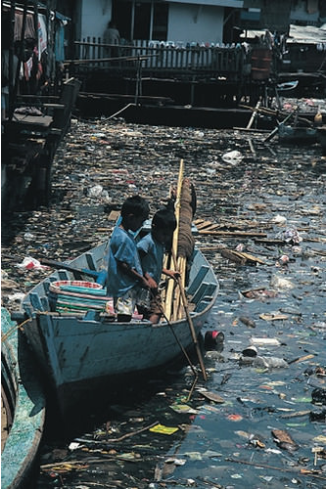
Water pollutants can move through different water reservoirs, as the water carrying them progresses through stages of the water cycle (Figure \(\PageIndex{5}\)). Water residence time (the average time that a water molecule spends in a water reservoir) is very important to pollution problems because it affects pollution potential. Water in rivers has a relatively short residence time, so pollution usually is there only briefly. Of course, pollution in rivers may simply move to another reservoir, such as the ocean, where it can cause further problems. Groundwater is typically characterized by slow flow and longer residence time, which can make groundwater pollution particularly problematic. Finally, pollution residence time can be much greater than the water residence time because a pollutant may be taken up for a long time within the ecosystem or absorbed onto sediment.
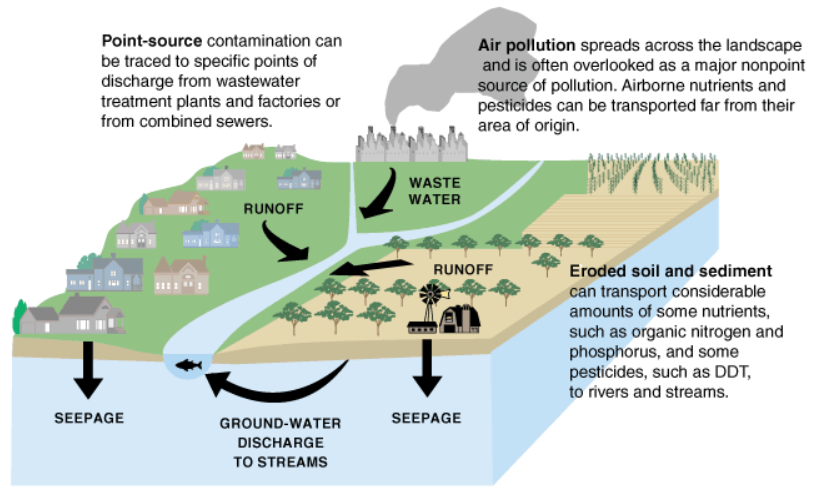
Like air pollution, water pollutants may enter the water cycle from point sources, which include identifiable and (generally) relatively small locations, or nonpoint sources, which include large and more diffuse areas. Point sources of pollution include animal factory farms (Figure \(\PageIndex{6}\)) that raise a large number and high density of livestock such as cows, pigs, and chickens.
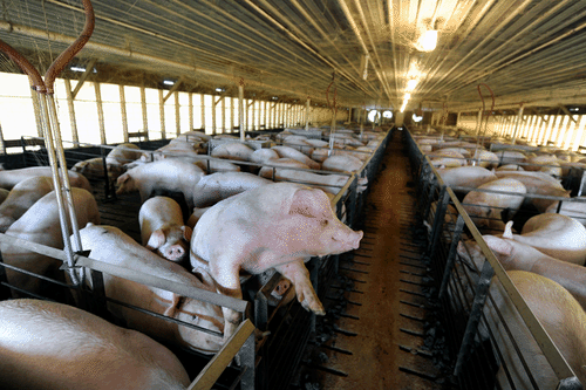
Included in point sources are pipes from factories or sewage treatment plants. Combined sewer systems that have a single set of underground pipes to collect both sewage and stormwater runoff from streets for wastewater treatment can be major point sources of pollutants. During heavy rain, stormwater runoff may exceed sewer capacity, causing it to back up and spilling untreated sewage directly into surface waters (Figure \(\PageIndex{7}\)).
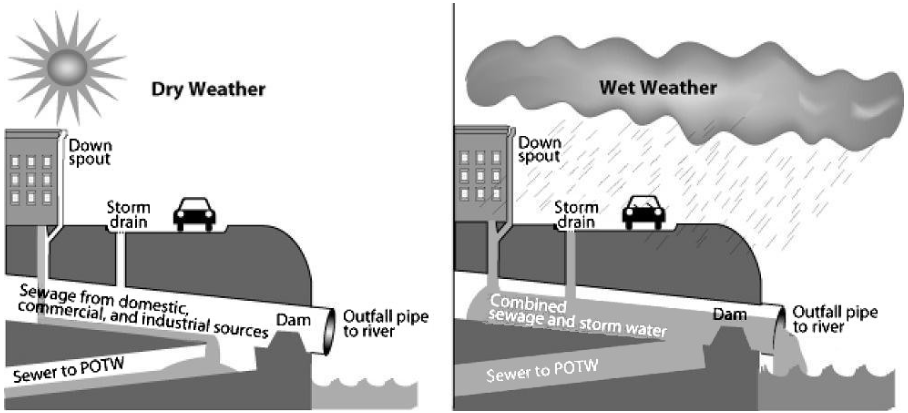
Non-point sources of pollution include agricultural fields, cities, and abandoned mines. Rainfall runs over the land and through the ground, picking up pollutants such as herbicides, pesticides, and fertilizer from agricultural fields and lawns; oil, antifreeze, animal waste, and road salt from urban areas; and acid and toxic elements from abandoned mines. Then, this pollution is carried into surface water bodies and groundwater. Non-point source pollution, which is the leading cause of water pollution, is usually much more difficult and expensive to control than point source pollution because of its low concentration, multiple sources, and much greater volume of water.
In this 9-minute video, discover how the plastic we dump into the ocean might be hiding in plain sight.
Question after watching: What is the ultimate solution to plastic waste in the ocean? What part can individuals play in this solution? What part can corporations play?
Population
Humans, while subject to the same ecological constraints as any other species (a need for nutrients, water, etc.), have some features as individuals and some as a population that make them a unique species. Unlike most other organisms, humans have the capacity to alter their number of offspring, level of resource consumption and distribution. While most women around the world could potentially have the same number of children during their lives, the number they actually have is affected by many factors. Depending upon technological, cultural, economic and educational factors, people around the world have families of different sizes. Additionally, unlike other organisms, humans invent and alter technology, which allows them to change their environment. This ability makes it difficult to determine the human carrying capacity (Figure \(\PageIndex{8}\)).
For example, families in developing nations are often larger, but less resource-intensive (e.g., they use fewer resources per person) than those in more developed nations. However, increasingly, human populations wish to have a "western" standard of living. An increase in the world’s average standard of living significantly lowers the potential human carrying capacity of the earth. Therefore, in order to reduce their impact as a species, humans must not only reduce the resources they use per person, they must also reduce their average family size.
Human Resource Utilization
Humans have always made an impact on the environment through their use of resources. For example, early humans were primarily hunter-gatherers who used tools to survive. They fashioned wood and stone tools for hunting and food preparation, and used fire for cooking. Early humans developed methods for changing habitats to suit their needs and herding wild animals. As time passed, humans developed more tools and techniques and came to rely on that technology in their daily lives. Although the tools of early humans were primitive by today's standards, they significantly affected the environment and probably hastened the extinction of some large Ice Age mammals.
Over the last 10,000 years, land clearing for agriculture has destroyed and degraded the habitats of many species of plants and animals. Today, growing populations in less developed countries are rapidly clearing tropical forests and savannas for agricultural use. These tropical rainforests and savannas provide habitat for most of the earth's species. It has become clear that modern agricultural practices are not sustainable. Once-fertile areas are becoming infertile because of overgrazing, erosion and nutrient depletion. Furthermore, modern agriculture requires large inputs of energy and fertilizers, usually produced from nonrenewable fossil fuels.
Advanced industrialization leads to many changes in human society, and some of those changes negatively affect the supply of natural resources and result in environmental degradation. These changes include increased production and consumption of goods by humans, dependence on non-renewable resources such as oil and coal, production of synthetic materials (which may be toxic or non-biodegradable), and consumption of large amounts of energy at home and work. For example, if everyone on the planet lived as the average American, humanity would need the equivalent of 7.5 Earths to support everyone.
Other changes may have positive benefits. These include the creation and mass production of useful and affordable products, significant increases in the average gross national product per person, large increases in agricultural productivity, sharp rises in average life expectancy, and a gradual decline in population growth rates. The information age was born with the invention of miniaturized electronics such as integrated circuits and computer central processing units. This stage in human development has changed and continues to change society as we know it. By making good use of information technologies, less developed countries may be able to reduce potential environmental problems as their economies expand in the future. With so much information easily available, developing countries may not repeat the environmental mistakes that more developed countries made as they became industrialized.
Predator Losses
"The loss of apex consumers is arguably humankind’s most pervasive influence on the natural world. This is true in part because it has occurred globally and in part because extinctions are by their very nature perpetual, whereas most other environmental impacts are potentially reversible on decadal to millenial time scales. Recent research suggests that the disappearance of these animals reverberates further than previously anticipated, with far-reaching effects on processes as diverse as the dynamics of disease; fire; carbon sequestration; invasive species; and biogeochemical exchanges among Earth’s soil, water, and atmosphere."1 The loss of these predators leads to what is known as trophic cascades.
"Predation is ubiquitous in nature and can be an important component of both ecological and evolutionary interactions. One of the most striking features of predators is how often they cause evolutionary diversification in natural systems. Predators are effective agents of natural selection because they possess key traits that allow them to capture and consume their prey; they adopt different strategies to do so, and they are common, but not too common, such that they can drive prey evolution without driving prey species to extinction."2
"Classic ecological studies that viewed predators as static entities that interact with prey in fixed ways resulting in predictable population dynamics are likely too simplistic. Today it is recognized that both predator and prey populations evolve—and that this evolution can happen very rapidly, even on ecological time scales, often with more than two species involved."2
"Ecosystems may be shaped by the loss of consumers. The loss of a single predator species may reverberate through the community. The loss of apex consumers reduces food chain length, thus altering the intensity of herbivory and the abundance and composition of plants in largely predictable ways. The transitions in ecosystems that characterize such changes are often abrupt, are sometimes difficult to reverse, and commonly lead to radically different patterns and pathways of energy and [matter]."2
Scientists have discovered that reintroducing apex predators has led to successful recovery of previously damaged ecosystems, profiled in this 6-minute video from the IUCN.
Question after watching: Why do apex predators play such a crucial role in ecosystems and how can we effectively preserve them?
Wolves are a keystone species in Yellowstone National Park, Wyoming, USA. Predict what would happen if they were hunted to extinction.
- Many species would increase and the elk population would disappear.
- Many species would disappear and the elk population would initially increase.
- Many species along with elk population would increase.
- Many species, along with the elk population, would disappear.
- Answer
-
B. Many species would disappear and the elk population would initially increase.
Overharvesting
Overharvesting is a serious threat to many species, but particularly to aquatic species. There are many examples of regulated fisheries (including hunting of marine mammals and harvesting of crustaceans and other species) monitored by fisheries scientists that have nevertheless collapsed. The western Atlantic cod fishery is the most spectacular recent collapse. While it was a hugely productive fishery for 400 years, the introduction of modern factory trawlers in the 1980s and the pressure on the fishery led to it becoming unsustainable. The causes of fishery collapse are both economic and political in nature.
Most fisheries are managed as a common resource, available to anyone willing to fish, even when the fishing territory lies within a country’s territorial waters. Common resources are subject to an economic pressure known as the tragedy of the commons, in which fishers have little motivation to exercise restraint in harvesting a fishery when they do not own the fishery. The general outcome of harvests of resources held in common is their overexploitation. While large fisheries are regulated to attempt to avoid this pressure, it still exists in the background. This overexploitation is exacerbated when access to the fishery is open and unregulated and when technology gives fishers the ability to overfish. In a few fisheries, the biological growth of the resource is less than the potential growth of the profits made from fishing if that time and money were invested elsewhere. In these cases—whales are an example—economic forces will drive toward fishing the population to extinction.
Learn about overfishing and its effects on ecosystems, food security, jobs, economies, and coastal cultures in this 4.5-minute video.
Question after watching: What can communities do to ensure their local waters are fished sustainably?
Coral reefs are extremely diverse marine ecosystems that face peril from several processes. Reefs are home to 1/3 of the world’s marine fish species—about 4,000 species—despite making up only one percent of marine habitat. Most home marine aquaria house coral reef species that are wild-caught organisms—not cultured organisms. Although no marine species is known to have been driven extinct by the pet trade, there are studies showing that populations of some species have declined in response to harvesting, indicating that the harvest is not sustainable at those levels. There are also concerns about the effect of the pet trade on some terrestrial species such as turtles, amphibians, birds, plants, and even the orangutans Figure \(\PageIndex{9}\).

Many around the world eat wild animals for food. Hunting is practiced throughout the world, but hunting practices, particularly in equatorial Africa and parts of Asia, are believed to threaten several species with extinction. Traditionally, wild meat in Africa was hunted to feed families directly. However, recent commercialization of the practice now has wild meat available in grocery stores, which has increased harvest rates to the level of unsustainability. Additionally, human population growth has increased the need for protein foods that are not being met from agriculture. Species threatened by the wild meat trade are mostly mammals including many monkeys and the great apes living in the Congo basin.
Climate Change
Climate change, and specifically the anthropogenic (meaning, caused by humans) warming trend presently underway, is recognized as a major extinction threat, particularly when combined with other threats such as habitat loss. Extinction rate estimates range from 15 percent to 40 percent of species committed to extinction by 2050 due to climate change. Climate change will alter regional climates, including rainfall and snowfall patterns, making habitats less hospitable to the species living in them. The warming trend will shift colder climates toward the north and south poles, forcing species to move with their adapted climate norms while facing habitat gaps along the way.
The shifting ranges will impose new competitive regimes on species as they find themselves in contact with other species not present in their historic range. One such unexpected species contact is between polar bears and grizzly bears (Figure \(\PageIndex{10}\)). Previously, these two species had separate ranges. Now, their ranges are overlapping and there are documented cases of these two species mating and producing viable offspring. Changing climates also throw off species’ delicate timing adaptations to seasonal food resources and breeding times. Many contemporary mismatches to shifts in resource availability and timing have already been documented.
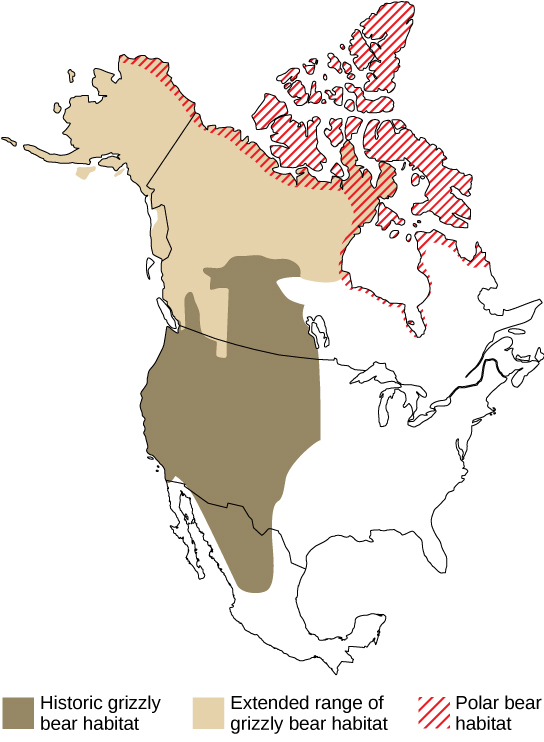
Range shifts are already being observed: for example, some European bird species ranges have moved 91 km northward. The same study suggested that the optimal shift based on warming trends was double that distance, suggesting that the populations are not moving quickly enough. Range shifts have also been observed in plants, butterflies, other insects, freshwater fishes, reptiles, and mammals.
Climate gradients will also move up mountains, eventually crowding species higher in altitude and eliminating the habitat for those species adapted to the highest elevations. Some climates will completely disappear. The rate of warming appears to be accelerated in the Arctic, which is recognized as a serious threat to polar bear populations that require sea ice to hunt seals during the winter months: seals are the only source of protein available to polar bears. A trend towards decreasing sea ice coverage has occurred since observations began in the mid-twentieth century. The rate of decline observed in recent years is far greater than previously predicted by climate models.
Finally, climate change will raise ocean levels due to meltwater from glaciers and the greater volume of warmer water. Shorelines will be inundated, reducing island size, which will have an effect on some species, and a number of islands will disappear entirely. Additionally, the gradual melting and subsequent refreezing of the poles, glaciers, and higher-elevation mountains—a cycle that has provided freshwater to environments for centuries—will also be jeopardized. This could result in an overabundance of salt water and a shortage of fresh water.
More on climate change follows in Unit 5.3.
This 6-minute video from PBS discusses that as the world figures out how to live with a rapidly changing climate, traditional knowledge from indigenous cultures could help Western Science understand just how things are transforming.
Question after watching: In what ways is Indigenous Science dynamic regarding climate change? In what areas are Indigenous people facing discrimination in science?
Converting a prairie to a farm field is an example of ________.
- overharvesting
- habitat loss
- exotic species
- climate change
- Answer
-
B. habitat loss
Loss of biodiversity and acceleration of extinction rates have several causes. Which of the following situations causes direct loss of biodiversity owing to overexploitation?
- fishing cod at a rate that is greater than natural replacement
- building a housing subdivision in place of second-growth forest
- introduction of an invasive ornamental plant in a new ecosystem
- emission of greenhouse gases increasing the average temperatures of an area
- Answer
- A. fishing cod at a rate that is greater than natural replacement
In this 3.5-minute video, learn of a 2019 United Nations report that says humans are transforming the planet’s natural habitat at an unprecedented rate.
Question after watching: Are you optimistic or pessimistic of humans' capability to change and reduce their collective ecological footprint?
Footnotes:
1. Estes, J.A. et al. 2011. Trophic Downgrading of Planet Earth. Science. 333(6040): 301-306: https://doi.org/10.1126/science.1205106
2. Johnson, J.B. and M.C. Belk. 2020. Predators as Agents of Selection and Diversification. Diversity. 12(11): 415; https://doi.org/10.3390/d12110415


